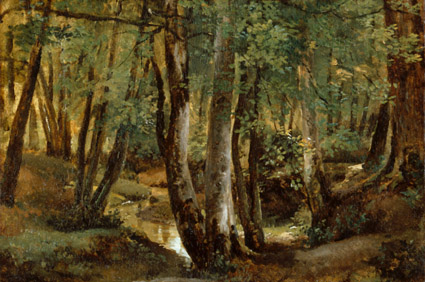PLEIN-AIR PAINTING IN EUROPE 1780-1850
Saturday 4 September to Sunday 31 October 2004

The Impressionists were not the first to paint in the open air. The vibrant oil sketches of Corot and Constable, for example, were painted out of doors, en plein air, and record direct personal responses to landscape. Scores of artists in the late 18th and early 19th centuries - Belgian, British, Danish, French, German, Italian, Norwegian - shared this passion: to capture spontaneous 'impressions' of nature by painting in the open air.
The oil sketches were private, personal works never intended for exhibition or sale. Few of the open-air sketchers made a big reputation with their finished works, which were more academic. The sketches sank into anonymous obscurity only to be re-evaluated by collectors and scholars in the second half of the 20th century.
For the first time in Australia, oil sketches are explored in a major touring exhibition. Organised by the Prefectural Museum of Shizuoka in Japan, Plein-air painting in Europe 1780-1850 draws mainly from private collections in Europe and the US (including the Wheelock Whitney and Thaw collections), to present a varied array of these vivid 'impressions before Impressionism'. 84 paintings, 12 drawings and 6 prints have been selected by the exhibition curator, Yukitaka Kohari for inclusion in this exhibition.
The traditional distinction between sketch and finished painting was abandoned in the 1870s. This, together with the introduction of a new range brightly-coloured pigments (and the invention of the metal paint tube available from c.1840) gave us the 'Impressionis' we know. However, a revolution in painters' visual responses to nature had already happened.
The significance of the oil-sketch tradition was underlined by Peter Galassi in a major exhibition organised by MOMA New York in 1981: Before Photography, Painting and the Invention of Photography.
'The sketch was � a loophole in the traditional artistic practice, which allowed a generally unacknowledged but formidable shift in artistic values to develop. Thus, although lacking the status of high art and rarely receiving full artistic attention, the landscape sketch - particularly the landscape sketch in oil - became around 1800 the primary vehicle of a tentative but profoundly original sense of pictorial order, based on a heretical concern for the visual aspect of the most humble things�.
It is a well-known clich� to suggest that Impressionism was a reaction to the invention of photography. Galassi argued that the invention of photography was a reaction to the plein-air oil sketch. A new way of seeing and depicting nature, already present in the sketches, made the idea of landscape photography thinkable.
The rediscovery of the plein-air oil sketch tradition is a relatively recent phenomenon. In the catalogue's introductory essay, Philip Conisbee, Senior Curator of European Art at the National Gallery of Art, Washington, states that 'a significant chapter has been added in approximately the last thirty years to the history of European painting'.
In the last decade the early masters of the plein-air oil sketch have been the subject of major exhibitions in Washington, London, Paris and elsewhere. New artists, until recently neglected in public galleries, are emerging from the private collections where they have been treasured by a small group of pioneer collections.
The new interest is reflected in the acquisition within the last five years of major collections of oil sketches by the National Gallery in London (Gere collection), the Metropolitan Museum in New York (Wheelock Whitney collection) and the Pierpont Morgan Library, New York (Thaw collection).
Plein-air painting in Europe 1780-1850 includes the pioneers of plein-air painting from the late 18th-century Pierre-Henri de Valenciennes (1750-1819) and Thomas Jones (1742-1803), as well as the big names Jean-Baptiste-Camille Corot (1796-1875) and John Constable (1776-1836). The real opportunity presented by this exhibition is to discover a wide range of open-air painters whose works have only recently been rediscovered and re-evaluated. These include Simon Denis (1755-1812), Alexandre-Hyacinthe Dunouy (1757-1841), Jean-Joseph-Xavier Bidauld (1758-1846), Fran�ois-Marius Granet (1775-1849), Jean-Victor Bertin (1767-1842), Achille-Etna Michallon (1796-1822), Johan Christian Clausen Dahl (1788-1857), as well as around 40 others.
The Australian 'Impressionists' continued the tradition of the small, portable plein-air oil-sketch into the 20th century. A selection of Australian works, made by Richard Beresford, senior curator of European Art and Barry Pearce, head curator of Australian Art at the Art Gallery of New South Wales, includes plein-air sketches by Roberts, Streeton, McCubbin and Gruner. "The exhibition places these works in their true context: not of the French Impressionists, but in a well-established European tradition of sketching from nature in oils," said Beresford and Pearce.
Venues
The Shizuoka Prefectural Museum of Art, 22 June to 15 August 2004
Art Gallery of New South Wales, 4 September to 31 October 2004
National Gallery of Victoria, 19 November 2004 to 16 January 2005
|